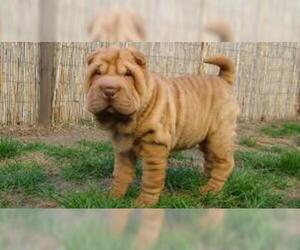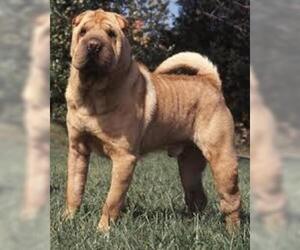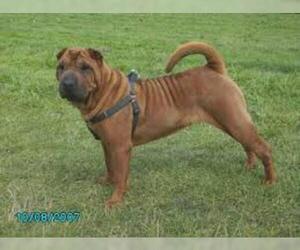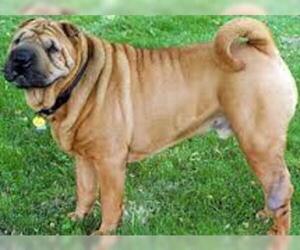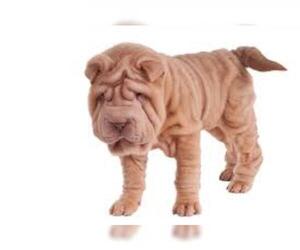
All about Chinese Shar-Pei dog breed
A.K.A. :Wrinkled Dog, Chinese Fighting Dog, Dah-Lot, Meat-Mouth Dog, Hippopotamus Dog, Shar-Pei, Shar Pei, Shar-Pei Dog
Size
Grooming requirements
Exercise requirements
Good with other dogs
Watchdog ability
Energetic
Training requirements
Playful
Affectionate
Good with other pets
Good with children
Good with strangers
Winter
Summer
Healthiness
Protective
Life Span
| Pure Breeds | Member |
| Breeds A - Z | C |
| Breeds by Group | Non-Sporting Northern |
| Breeds by Trait | Good With Kids Low Shedding |
| Overview: | The Chinese Shar-Pei is an ancient and distinctive breed, originating in southern China where they were historically used as farm dogs, hunters, and guardians. Their most striking physical characteristic is their loose, wrinkled skin, particularly prominent in puppies, and their unique "hippopotamus" muzzle. They are a medium-sized dog with a short, rough coat that comes in a variety of solid colors. Temperament-wise, Shar-Peis are often described as independent, intelligent, and fiercely loyal to their families, though they can be reserved with strangers. Early socialization is crucial to foster their confident and calm nature. While generally good with children in their own family, their independent streak means they thrive in homes that understand and respect their unique personality. Their relatively low exercise needs and adaptable nature make them suitable for apartment living, provided they receive regular walks and mental stimulation. Owners should be aware of potential health considerations, including skin fold infections, entropion (an eyelid condition), and certain allergies, requiring attentive care and regular veterinary check-ups. |
F.A.Q.
All You Need to Know About the Chinese Shar-Pei Breed
The Chinese Shar-Pei, a distinctive breed originating from southern China, is renowned for its deep wrinkles and "hippopotamus" muzzle. These loyal and independent dogs typically display a calm demeanor, making them excellent family companions for those who appreciate a less outwardly affectionate pet. Shar-Peis are generally good with children if socialized early, and their moderate size makes them adaptable to apartment living with sufficient daily walks. Their short, bristly coat requires minimal grooming, primarily regular brushing to remove loose hair. Exercise needs are moderate; a daily walk and some playtime suffice. Potential owners should be aware of common Shar-Pei health issues like skin fold infections, entropion (eyelid condition), and Shar-Pei fever, underscoring the importance of choosing a reputable breeder. With proper care and socialization, the Chinese Shar-Pei is a unique and devoted companion.The average weight of a Chinese Shar-Pei typically ranges from 45 to 60 pounds. This makes them a medium-sized breed. While individual variations occur, healthy adult Chinese Shar-Pei generally fall within this range.
There can be a slight difference in Chinese Shar-Pei weight between sexes:- Males: Often on the higher end, averaging 55-60 pounds.
- Females: Usually a bit lighter, averaging 45-55 pounds.
What is the average height of a Chinese Shar-Pei in inches?
When considering a Chinese Shar-Pei, understanding their average size is helpful for potential owners. The typical Chinese Shar-Pei height for an adult dog, measured at the shoulder (withers), falls within a consistent range. You can expect your Shar-Pei to stand between 18 to 20 inches tall.This range represents the breed standard and is a good indicator of "how tall is a Chinese Shar-Pei" generally gets. While there isn't a significant difference in height between males and females in this breed, you might occasionally see a male at the higher end of the spectrum and a female at the lower end. However, individual genetics and nutrition during growth can also play a role, leading to slight variations outside this average. Rest assured, a healthy adult Shar-Pei will typically mature within this 18-20 inch height bracket, making them a medium-sized dog with a sturdy build.The Chinese Shar-Pei colors are diverse, offering a range of options for potential adopters. AKC recognized Chinese Shar-Pei colors include solid shades such as black, cream, fawn, red, sable, and apricot. These are the standard colors you'll most commonly find and are accepted for show by major kennel clubs.Beyond the officially recognized, you'll also encounter rare coat types and exotic Chinese Shar-Pei variations. These can include blue, which ranges from a charcoal gray to a lighter slate; lilac, a dilute chocolate that often has a pinkish-gray hue; and chocolate, a rich dark brown. While beautiful, these specific dilute and brown shades are typically not recognized for conformation showing by the AKC. Brindle and sable are also recognized, with sable being a fawn base with black tipping. White Shar-Pei are also seen, often referred to as "snow Shar-Pei," and are usually a very light cream. It's important to note that merle is not a naturally occurring color in the Shar-Pei breed and any Shar-Pei advertised with a merle coat should be approached with caution, as it often indicates cross-breeding. When comparing Chinese Shar-Pei colors and pricing, recognized colors are generally more common, while rare and exotic variations may command a higher price due to their uniqueness.
The Chinese Shar-Pei personality is often described as dignified, independent, and intelligent. They are typically loyal and devoted to their families, often forming strong bonds with their primary caregivers. While they can be affectionate with their own people, they are not typically outwardly demonstrative and may even appear aloof to strangers. In terms of temperament of Chinese Shar-Pei with children, they can be good companions if raised with them from a young age and properly socialized. Supervision is always recommended, especially with very young children, as their independent nature means they may not tolerate rough play. When it comes to other pets, early socialization is crucial. Shar-Pei can be dominant with other dogs, especially those of the same sex, so careful introductions and continued training are essential.Regarding adaptability to apartment living, Shar-Pei can do well in apartments as long as they receive adequate exercise, mental stimulation, and regular walks. They are not high-energy dogs, but daily activity is important to prevent boredom and maintain their health. Their independent nature means they are generally not prone to separation anxiety if accustomed to being alone, but they still require attention and interaction. Their reserved nature with strangers makes them excellent watchdogs.
The Chinese Shar-Pei temperament is often described as loyal, independent, and devoted to their family. They are known for forming strong bonds with their owners, making them excellent companion dogs. While typically calm and dignified, they can be somewhat reserved and wary of strangers, requiring proper socialization from a young age to develop a well-adjusted personality. Friendliness and Sociability: Shar-Peis are not overtly friendly with everyone they meet. They tend to be more aloof with strangers but affectionate and playful with their family. Their sociability with other dogs and pets varies greatly; some can coexist peacefully, while others may prefer to be the sole pet. Early and consistent socialization is crucial for positive interactions.Loyalty and Protectiveness: Their loyalty to their human family is a hallmark of the breed. They can be protective, making them good watchdogs, but they are not typically aggressive without reason.Adaptability to Apartment Living: With adequate daily exercise, the Chinese Shar-Pei can adapt well to apartment living. They are not overly energetic indoors but do enjoy outdoor walks and playtime.Behavior with Children and Other Pets: When raised with children and other pets, and properly socialized, Shar-Peis can be tolerant and loving. However, due to their independent nature and potential for sensitivity, supervision is always recommended, especially with very young children. They might not be the best fit for homes with boisterous, untrained children.Stubbornness and Sensitivity: Shar-Peis possess an intelligent but often stubborn streak, requiring a firm, consistent, and positive training approach. They are also quite sensitive and do not respond well to harsh corrections, which can damage their trust and lead to behavioral issues. Understanding their unique disposition is key to a harmonious relationship.
Chinese Shar-Pei Care: Essential Daily MaintenanceChinese Shar-Pei care is unique due to their distinctive features. Grooming needs are minimal for their short coat, requiring only weekly brushing to remove loose hair. However, wrinkle cleaning is crucial to prevent skin infections; gently wipe deep folds daily with a damp cloth and ensure they are thoroughly dry. Regular ear cleaning is also vital to prevent infections, especially for their small, folded ears.Exercise limitations are important to note. Shar-Peis are a low-energy dog breed and prone to overheating due to their brachycephalic (short-nosed) anatomy. Short, moderate walks are sufficient, and avoid strenuous activity in hot weather. Their brachycephalic nature also means they are susceptible to climate sensitivity; always ensure they have a cool, shaded environment.Dietary considerations involve a high-quality, balanced diet appropriate for their age and activity level. Monitor portion sizes closely for weight management as they are prone to obesity, which can exacerbate existing health issues.Common health concerns include various skin issues (like pyoderma and allergies), eye problems (entropion), and hip/elbow dysplasia. Regular veterinary check-ups are essential. Dental care is paramount; daily brushing helps prevent periodontal disease. Understanding how to care for a Chinese Shar-Pei means being proactive with their specific needs. These health tips for Chinese Shar-Pei will help ensure a long, healthy life for your companion.
The Chinese Shar-Pei activity level is generally moderate. They are not high-energy dogs, but they do require daily exercise needs to stay healthy and happy. Expect a balance of short bursts of energy followed by long periods of rest.How active are Chinese Shar-Pei? They typically enjoy a daily walk of 20-30 minutes and some controlled playtime in a secure yard. Their playtime preferences often include sniffing around, chasing a ball for a few throws, or gentle games. Due to their brachycephalic (short-nosed) anatomy, it's crucial to limit strenuous exercise, especially in warm or humid weather, to prevent overheating and respiratory distress.Chinese Shar-Pei are suitable for low-to-moderately active households rather than very active families seeking a running or hiking companion. They are generally content with a comfortable routine and quality time with their owners. While they have periods of playful energy, they are also known for their calm and independent nature indoors.
Chinese Shar-Pei Health Issues: A Comprehensive Guide
The unique appearance of the Chinese Shar-Pei is undeniably charming, but potential owners must be aware of the breed's propensity for specific health concerns. Understanding these common Chinese Shar-Pei medical issues is crucial for providing proper care and ensuring a long, happy life for your wrinkled companion.One significant concern for the Shar-Pei is Brachycephalic Obstructive Airway Syndrome (BOAS). While not as extreme as some other flat-faced breeds, their slightly shortened muzzle can lead to breathing difficulties, especially in warm weather or during strenuous exercise. Symptoms include noisy breathing, snoring, and an intolerance to heat. Brachycephalic dog care involves avoiding overheating, limiting exercise in high temperatures, and using a harness instead of a collar to reduce pressure on the trachea.Hip dysplasia is another prevalent skeletal issue, where the hip joint doesn't form correctly, leading to pain and arthritis. Responsible breeders screen their dogs for this condition. Early signs include lameness, difficulty rising, and reluctance to jump. Maintaining a healthy weight and providing joint supplements can help manage the condition.The Shar-Pei's distinctive wrinkles, while adorable, are prone to skin fold infections (pyoderma). Moisture and bacteria can become trapped in these deep folds, leading to irritation, redness, and odor. Regular cleaning and drying of the skin folds with vet-approved wipes or solutions are essential to prevent these infections. Allergies are also common, often manifesting as skin irritation, itching, and ear infections. Identifying and avoiding allergens, along with veterinary prescribed medications, are key to managing these conditions.Spinal problems, such as intervertebral disc disease, can occur in the breed. This condition affects the discs between the vertebrae, potentially causing pain, weakness, or even paralysis. Maintaining a healthy weight and avoiding excessive jumping can help reduce the risk.Finally, due to their unique facial structure and overall physiology, heat sensitivity is a major concern. Shar-Peis can quickly overheat, leading to heatstroke, which is a medical emergency. Always provide access to fresh water, shade, and air conditioning. Avoid strenuous exercise during hot weather.To learn how to keep Chinese Shar-Pei healthy, proactive veterinary care, a balanced diet, regular exercise tailored to their needs, and meticulous attention to skin fold hygiene are paramount. Understanding these potential challenges allows you to be a well-prepared and responsible owner, contributing to your Shar-Pei's overall well-being.Breed Breakdown: What Experts Say About the Chinese Shar-Pei
I would rate the "Size" trait of the Chinese Shar-Pei a 4 out of 10. They are a medium-sized breed, falling comfortably between smaller companion dogs and larger working breeds. With an average height of 18-20 inches and a weight of 45-60 pounds, their sturdy, compact build makes them noticeably larger than a toy breed, but far from the imposing presence of a Great Dane or Irish Wolfhound. Their moderate dimensions make them well-suited for apartment living, especially with regular exercise, and their size generally allows for easier travel compared to giant breeds. They can certainly adapt to households with space constraints, as long as they receive sufficient mental and physical stimulation.
I would rate the Chinese Shar-Pei's grooming requirements as a 6.While their short, bristly coat is relatively low-maintenance in terms of brushing (shedding is moderate), the breed's defining characteristic – its wrinkles – necessitates regular and specialized care. These skin folds are prone to trapping moisture, dirt, and bacteria, making them a breeding ground for skin infections and yeast issues if not cleaned meticulously and dried thoroughly. This often requires daily or every-other-day attention, especially for puppies with more prominent folds. They are also prone to certain skin conditions and allergies, which can further increase the need for medicated baths or topical treatments. Ear cleaning is also crucial as their small, "shell" ears can be prone to infections. Nail trimming and bathing are fairly standard for a dog of their size and coat type. Compared to many other companion dogs with similar short coats, the Shar-Pei requires significantly more focused attention on skin and fold hygiene, pushing them into the moderately high-maintenance category due to the specific challenges presented by their unique anatomy.
I would rate the Chinese Shar-Pei's exercise requirements at a 3 out of 10.While not a complete couch potato, the Shar-Pei generally has low to moderate exercise needs. They are not built for endurance and their brachycephalic (short-nosed) anatomy can make them prone to overheating and breathing difficulties, especially in warm weather or during strenuous activity. Daily walks of 20-30 minutes, combined with some dedicated playtime in a securely fenced yard, are usually sufficient to keep them healthy and content. They are generally content with a more relaxed pace of life and do not thrive on extensive, structured exercise routines. Over-exertion can be detrimental to their health, and they are more likely to enjoy a leisurely stroll than an intense run or demanding agility course. Mental stimulation through training and puzzle toys is often more important for them than high-impact physical activity.
I'd rate the Chinese Shar-Pei's "Watchdog Ability" at a 7 out of 10.Shar-Peis are naturally quite alert and possess strong territorial instincts, making them effective at detecting unusual activity. They are known to be suspicious of strangers and will typically bark to signal the presence of someone unfamiliar or an unexpected noise, providing meaningful early warnings in a home environment. Their deeply wrinkled brows and serious expressions can also be a deterrent to potential intruders. However, while they are excellent at alerting, their willingness to engage in prolonged confrontation or be truly aggressive to physically deter an intruder can vary more than some other dedicated protection breeds. They are more likely to create a racket and stand their ground rather than launch a full-scale attack, making them more of a vigilant early warning system than a fearless guard dog.
I would rate the "Good with Other Dogs" trait of the Chinese Shar-Pei a 3 out of 10.Shar-Pei generally lean towards being dog-selective rather than inherently dog-friendly. Their strong prey drive, guardian instincts, and often dominant personalities mean they frequently view other dogs with suspicion or as rivals, particularly those of the same sex. While early and consistent socialization is absolutely critical and can mitigate some of these tendencies, it's not a guarantee they will become truly sociable. They often require very careful, controlled introductions and constant supervision, especially with unfamiliar dogs or those with different energy levels. Multi-dog households can work, but typically only with very specific pairings (often opposite sexes and differing temperaments) and a lot of management. Aggression or dominance can be a significant concern without proper training and a clear pack hierarchy established by their human. They are not a breed that typically thrives in random canine company and usually prefer to be the sole recipient of their owner's attention, or at best, coexist peacefully with a carefully selected companion.
I would rate the "Energetic" trait of the Chinese Shar-Pei breed as a 3.Shar-Peis are generally a more laid-back and reserved breed compared to many other companion dogs. Their typical activity level is moderate at best, preferring short bursts of activity followed by long periods of relaxation. While puppies can be playful, this tends to wane as they mature into adulthood. They have relatively low endurance and don't typically require extensive physical stimulation to be content. They are not naturally suited for high-intensity outdoor or athletic activities. Furthermore, their brachycephalic (short-nosed) anatomy significantly affects their stamina and exercise tolerance, making them prone to overheating and respiratory distress during strenuous activity. A leisurely walk or a supervised romp in a secure yard is usually sufficient to meet their exercise needs.
I would rate the training requirements of the Chinese Shar-Pei breed as a 7.While intelligent, Shar-Peis are renowned for their independent and often stubborn nature. Their attention span can be short if not engaged, and they aren't inherently driven to please their owners in the same way some other breeds are. This means responsiveness to commands often requires significant consistency and patience. Positive reinforcement is highly effective, but it needs to be implemented diligently and clearly, as they will quickly test boundaries if given the opportunity. They can be prone to selective hearing when something more interesting captures their attention. Due to their strong will and potential for guarding instincts if not properly socialized and trained from a young age, Shar-Peis are generally not beginner-friendly and thrive with experienced handling and structured, consistent routines. Owners need to establish themselves as the confident leader with fair but firm guidance to ensure a well-adjusted and obedient companion.
I'd rate the "Playful" trait of the Chinese Shar-Pei breed a 4 out of 10.While not entirely inactive, the Shar-Pei is generally a more laid-back and independent breed compared to many other companion dogs. They typically have a moderate activity level, enjoying a good walk but not necessarily demanding constant high-energy play. Their love for games and interaction tends to be more subdued; they might engage in short bursts of play with their favorite person, but aren't usually the type to endlessly chase a ball or initiate boisterous games. Attention-seeking behavior is present, but often manifests as a desire for quiet companionship rather than demanding playful interaction. They can enjoy toys, particularly puzzle toys or chew toys, but their enthusiasm for playtime often wanes quickly. Overall, their enthusiasm in daily life is more grounded and calm, rather than naturally spirited. They are generally content observing or lounging rather than constantly seeking active fun.
I would rate the Affectionate trait of the Chinese Shar-Pei a 7 out of 10.While not overtly demonstrative like some retriever breeds, the Shar-Pei forms an incredibly strong and loyal bond with their family. They certainly desire human companionship and will often be found in the same room as their owners, sometimes following them from room to room. They are sensitive to owner emotions and can offer quiet comfort. However, their physical closeness often manifests more as leaning or being nearby rather than constant lap-sitting or effusive cuddling, especially once they're adults. They have a dignified independence but are deeply devoted and will show their affection through their unwavering presence and loyalty. They thrive on the security and love of their family, but express it in a more reserved, yet profound, manner than many other companion dogs.
I would rate the "Good with Other Pets" trait of the Chinese Shar-Pei a 4 out of 10.While not inherently aggressive, the Shar-Pei's independent and often dominant nature means they are generally not naturally sociable with other animals. They possess a moderate to high prey drive, which can be an issue with cats or smaller pets, and strong resource guarding tendencies are common, particularly with food, toys, and their human companions. Early and extensive socialization from a very young age is absolutely crucial for them to even *tolerate* other pets, and even then, peaceful coexistence often requires consistent training, careful management, and constant supervision, especially with other dogs of the same sex. They are a breed that often prefers to be the sole recipient of attention and can be intolerant of other animals vying for their space or resources, making them a challenging choice for multi-pet households without significant effort and understanding from their owners. They are far from the "go-with-the-flow" type of pet-friendly dog.
The Chinese Shar-Pei rates a 4 on the "Good with Children" scale.While not inherently aggressive, Shar-Peis are a breed that requires significant early socialization and consistent training to be comfortable around children. Their independent and sometimes aloof nature means they aren't naturally inclined to be playful or overtly affectionate with kids. They have a lower tolerance for the sudden noises, boisterous play, and sometimes clumsy handling that come with children, especially younger ones. Their strong prey drive, though typically directed towards small animals, can sometimes be misdirected if not properly managed, and their protective instincts can lead to guarding behavior around their family and resources. They are not a breed that naturally possesses the patience or gentleness to thrive in a chaotic family setting without substantial effort from their owners. While they can coexist with older, respectful children under strict supervision and with established boundaries, they are not a breed known for being exceptionally child-friendly and are not recommended for families with very young children or those new to dog ownership.
I'd rate the "Good with Strangers" trait of the Chinese Shar-Pei a 3 out of 10.Shar-Pei are typically highly reserved and often wary of unfamiliar people. Their natural inclination is not to be outwardly friendly or welcoming, but rather to observe and often keep their distance. While some individuals, with extensive and early socialization, can learn to tolerate or even be politely aloof around strangers, they are rarely naturally outgoing. They possess a strong guarding instinct and are known for their loyalty to their family, which can translate into suspicion of outsiders. This wariness can sometimes manifest as barking or a watchful demeanor in public or guest-filled environments. While they aren't usually aggressive without provocation, their default setting is definitely not "friends with everyone." Extensive training and management are almost always required to ensure they are comfortable and well-behaved around new people, rather than being an inherent trait.
The Chinese Shar-Pei breed rates a 3 for "Winter" tolerance. Their short, single coat offers minimal insulation, making them highly susceptible to cold. While their wrinkled skin might provide a very slight buffer, it's insufficient to counter the lack of a dense undercoat or significant body fat for warmth. Their moderate size means they lose heat more rapidly than larger breeds, and while not severely brachycephalic, their facial structure still isn't ideal for sustained breathing in frigid air. They are at a heightened risk of hypothermia, particularly if exposed for extended periods without protection. Compared to many other companion dogs, Shar-Peis require special care during winter months; they cannot safely enjoy prolonged outdoor activity in cold climates and need to be protected with appropriate warm clothing (sweaters, coats) for even brief excursions. Their time outdoors should be limited, and owners must be vigilant about monitoring for signs of discomfort or cold exposure.
Rating: 3The Chinese Shar-Pei breed exhibits a low "summer" tolerance, earning a rating of 3. Their brachycephalic (short-nosed) anatomy significantly hinders their ability to efficiently cool themselves through panting, making them highly susceptible to overheating. They struggle to regulate their body temperature in warm weather, putting them at a high risk of heatstroke, even with moderate activity. Consequently, outdoor activity during summer months should be severely limited and restricted to early mornings or late evenings when temperatures are cooler. Compared to many other companion dog breeds, Shar-Peis require extensive special care in summer, including constant access to shade and fresh water, air-conditioned indoor environments, and strict avoidance of strenuous exercise. They are not a breed that can comfortably enjoy extended periods outdoors in typical summer temperatures without significant risk.
I would rate the Chinese Shar-Pei's "Healthiness" trait as a 3 out of 10.While responsible breeding and preventive care can mitigate some issues, the breed is unfortunately plagued by a multitude of genetic predispositions and common breed-specific health problems. Their distinctive wrinkles, a defining characteristic, often lead to chronic skin infections (pyoderma) and eyelid abnormalities (entropion) that require surgical correction. They are also prone to a debilitating inflammatory condition known as Shar-Pei fever, which can lead to kidney amyloidosis, a life-threatening disease. Other prevalent issues include various joint problems, breathing difficulties due to their brachycephalic tendencies (though less severe than some other brachycephalic breeds), and ear infections. Their life expectancy is generally shorter than many other breeds, often ranging from 8 to 12 years, and often involves significant veterinary intervention throughout. Compared to other companion dogs, the Chinese Shar-Pei is undoubtedly a high-maintenance breed when it comes to health, requiring diligent care and often costly medical treatments to manage their inherent vulnerabilities. They are far from generally robust and often present a significant challenge for owners seeking a low-health-risk dog.
I would rate the Shar-Pei's "Protective" trait at an 8 out of 10.The Shar-Pei is a remarkably alert and inherently territorial breed, making them excellent watchdogs. Their loyalty to their owners is profound, and they possess a strong instinct to protect their family and property. While not typically aggressive without cause, their reserved and often suspicious nature towards strangers means they are quick to bark and observe, acting as a deterrent. They are not naturally inclined to be "everyone's friend" and often require a significant period of observation before accepting new people into their space. This combination of alertness, territoriality, and loyalty makes them highly effective at signaling danger and creating a strong sense of security within the household. While primarily bred as a companion dog in modern times, their inherent protective instincts are strong enough that they are certainly capable of offering meaningful protection beyond just an alarm, and would not hesitate to put themselves between their family and a perceived threat.
I would rate the Chinese Shar-Pei's "Life Span" trait as a 5.While they can certainly live into their early teens, their average life expectancy of 8 to 12 years places them squarely in the average range for companion dogs. They are not considered exceptionally long-lived, nor are they particularly short-lived. This average rating is influenced by several common health issues and genetic predispositions, such as Shar-Pei fever, certain skin conditions, and eye problems, which can impact their overall longevity. Responsible breeding and diligent care, including a healthy diet and regular vet check-ups, can help maximize their lifespan, but these underlying health concerns prevent them from achieving a higher longevity rating compared to some healthier breeds.
Chinese Shar-Pei Puppies for saleSee all puppies for sale
Chinese Shar-Pei Dogs for adoptionSee all dogs for adoption
Chinese Shar-Pei BreedersSee all breeders
Similar Dog Breeds for Chinese Shar-Pei
Breed Mixes of Chinese Shar-Pei
Quick Breed Selector 0 - not important, 1 - smallest, 10 - largest
Variants & Mistakes :Chinese Sharpei, Chinese Shar Pei, Chinese Sharpie, Chinese Sharpay, Chinese Sher-pei, Chinese Sherpei, Chinese Sher Pei, Chinee Shar-Pei, Chinee Sharpei, Chinee Shar Pei, Chinee Sharpie, Chinee Sharpay, Chineese Shar-Pei, Chineese Sharpei, Chineese Shar Pei, Chineese Sharpie, Chineese Sharpay, Chines Shar-Pei, Chines Sharpei, Chines Shar Pei, Chines Sharpie, Chines Sharpay, Chinease Shar-Pei, Chinease Sharpei, Chinease Shar Pei, Chinease Sharpie, Chinease Sharpay, Chinesse Shar-Pei, Chinesse Sharpei, Chinesse Shar Pei, Chinesse Sharpie, Chinesse Sharpay, Chinese Shar-Pay, Chinese Shar-Pai, Chinese Shar-Pie, Chinese Shar-Pey, Chinese Sarpei, Chinese Sar-Pei, Chinese Sar Pei, Chinese Sar-Pay, Chinese Sar-Pai, Chinese Sar-Pie, Chinese Sar-Pey, Sharpei, Shar Pei, Shar-pei, Sharpie, Sharpay

